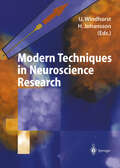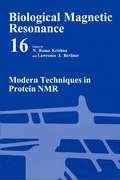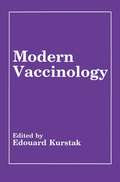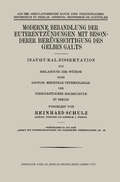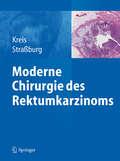- Table View
- List View
Modern Techniques in Biosensors: Detection Methods and Commercial Aspects (Studies in Systems, Decision and Control #327)
by Gorachand Dutta Arindam Biswas Amlan ChakrabartiThis book focusses on recent advances and different research issues in the biosensor technology and also presents theoretical, methodological, well-established and validated empirical work dealing with the technology. The book addresses challenges for the development of a point-of-care test platform. The book also describes printed chip-based assay (Lab-on-a-Chip, Lab-on-a-PCB) for rapid, inexpensive, multiplex detection of disease biomarkers in real samples. It aims to overcome existing barriers for Lab-on-a-Chip commercialization (lack of cost effective mass manufacturing methods, self-contained, fully autonomous operation and user-friendliness). Different advanced techniques including electrochemical, optical, mass, colorimetric and signal amplification strategies describe early stage disease diagnosis. The book gathers scientific and technological novelties and advancements already developed or under development in the academic and research communities. It covers a vast audience from basic science to engineering and technology experts and learners.
Modern Techniques in Neuroscience Research
by Uwe Windhorst Hakan JohanssonAn overview of the techniques used in modern neuroscience research with the emphasis on showing how different techniques can optimally be combined in the study of problems that arise at some levels of nervous system organization. This is essentially a working tool for the scientist in the laboratory and clinic, providing detailed step-by-step protocols with tips and recommendations. Most chapters and protocols are organized such that they can be used independently, while cross-references between the chapters, a glossary, a list of suppliers and appendices provide further help.
Modern Techniques in Protein NMR (Biological Magnetic Resonance #16)
by N. Rama Krishna Lawrence J. BerlinerVolume 16 marks the beginning of a special topic series devoted to modern techniques in protein NMR, under the Biological Magnetic Resonance series. This volume is being followed by Volume 17 with the subtitle Structure Computation and Dynamics in Protein NMR. Volumes 16 and 17 present some of the recent, significant advances in biomolecular NMR field with emphasis on developments during the last five years. We are honored to have brought together in these volumes some of the world’s foremost experts who have provided broad leadership in advancing this field. Volume 16 contains advances in two broad categories: the first, Large Proteins, Complexes, and Membrane Proteins, and second, Pulse Methods. Volume 17, which will follow covers major advances in Computational Methods, and Structure and Dynamics. In the opening chapter of Volume 16, Marius Clore and Angela Gronenborn give a brief review of NMR strategies including the use of long range restraints in the structure determination of large proteins and protein complexes. In the next two chapters, Lewis Kay and Ron Venters and their collaborators describe state-of-t- art advances in the study of perdeuterated large proteins. They are followed by Stanley Opella and co-workers who present recent developments in the study of membrane proteins. (A related topic dealing with magnetic field induced residual dipolar couplings in proteins will appear in the section on Structure and Dynamics in Volume 17).
Modern Therapeutics in Rheumatic Diseases
by George C. TsokosLeading clinicians and clinical researchers discuss in practical detail the newest treatments used in rheumatic diseases, emphasizing-without neglecting current standard treatments-those experimental therapies now undergoing clinical trials and poised for early introduction into the rheumatology armamentarium. The diseases and therapeutic regimes examined here range from rheumatoid arthritis and its treatment by gene therapy, to osteoarthritis and systemic autoimune diseases. Each chapter is organized so that the busy clinician can quickly obtain all the information needed optimal patient treatment. This includes an analysis of the pathogenic mechanisms that explain the molecular basis of the newer therapeutics, reviews of animal data and the results of clinical trials, and recommendations concerning use, side effects, and precautions.
Modern Thoraco-Lumbar Implants for Spinal Fusion
by Roberto Delfini Alessandro Landi Cristina Mancarella Fabrizio GregoriThis book presents an updated perspective on spinal implants currently used in thoraco-lumbar spine surgery, leading to a rigid or dynamic spine fusion. The development of new surgical devices and techniques is mostly focused on a spinal fusion for lumbar instability due to trauma, tumours or degenerative or infectious diseases. Pedicle-screw fixation and fusion are currently considered to be the gold standard for most of the above-mentioned pathologies, and modern implants are designed to improve the accuracy of pedicle-screw placement and to allow the use of new surgical techniques and minimally invasive approaches. The content is relevant for surgeons, orthopaedic specialists, neurosurgeons, physiotherapists and osteopaths.
Modern Tools and Methods of Water Treatment for Improving Living Standards: Proceedings of the NATO Advanced Research Workshop on Modern Tools and Methods of Water Treatment for Improving Living Standards, Dnepropetrovsk, Ukraine, November 19-22, 2003 (Nato Science Series: IV: #48)
by Alexander Omelchenko Alexander A. Pivovarov W. Jim SwindallProviding the population of the Earth with safe drinking water is one of the biggest challenges of modern society. In recognition of this problem the United Nations Organization and UNESCO declared 2003 to be the International Year of Freshwater. On November 19-22, 2003, the NATO Advanced Research Workshop (ARW) on “Modern Tools and Methods of Water Treatment for Improving Living Standards” took place in Dnepropetrovsk, Ukraine. Thirty-one participants from 15 countries including Bulgaria, Canada, Croatia, Czech Republic, Denmark, Italy, Lithuania, Moldova, Poland, Romania, Russia, UK, Ukraine, USA, and Uzbekistan attended the meeting. They discussed the scientific concepts and practical means for the solution of the complex social, economic and ecological problems associated with water purification, consumption, conservation, and protection. They also established a network of scientists and specialists to foster further collaboration and the exchange of ideas. The location of the ARW was chosen quite deliberately. The city of Dnepropetrovsk is located on the banks of the Dnieper River and it has a population of about 1. 3 million people. As it is one of the largest industrial centers, it shares all the environmental problems, which are found in the modern Ukraine. In 2001, one in seven of the water samples taken from Ukrainian industrial and drinking water supply systems did not meet sanitary-hygienic standards, and one in twelve did not meet microbiological standards.
Modern Tools of Biophysics (Handbook of Modern Biophysics #5)
by Thomas JueHandbook of Modern Biophysics brings current biophysics topics into focus, so that biology, medical, engineering, mathematics, and physical-science students or researchers can learn fun¬damental concepts and the application of new techniques in addressing biomedical challenges. Chapters will develop the conceptual framework of the physics formalism and illustrate the biomedical applica¬tions. With the addition of problem sets, guides to further study, and references, the interested reader can continue to independently explore the ideas presented.Volume 5: Modern Tools of BiophysicsEditor: Thomas Jue, PhDIn Modern Tools of Biophysics, a group of prominent professors have provided insights into the tools used in biophysics with respect to the following topics:Wave Theory of Image Formation in a Microscope: Basic Theory and ExperimentsComputer Simulations and Nonlinear Dynamics of Cardiac Action PotentialsMyoglobin and Hemoglobin Contribution to the NIRS Signal in MuscleAnomalous Low Angle X-Ray Scattering of Membrane with LanthanidesRecording of Ionic Currents under Physiological Conditions—Action Potential-Clamping and “Onion-Peeling” TechniquesPatch Clamp Technique and ApplicationsAbout the EditorThomas Jue is a Professor in the Department of Biochemistry and Molecular Medicine at the University of California, Davis. He is an internationally recognized expert in developing and applying magnetic resonance techniques to study animal as well as human physiology in vivo and has published extensively in the field of magnetic resonance spectroscopy and imaging, near-infrared spectroscopy, bioenergetics, cardiovascular regulation, exercise, and marine biology. He served as a Chair of the Biophysics Graduate Group Program at UC Davis, where he started to develop scholarly approaches to educate graduate students with a balance of physical-science/mathematics formalism and biomedical perspective in order to promote interest at the interface of physical science, engineering, mathematics, biology, and medicine. He continues to develop the biophysics curriculum, and the Handbook of Modern Biophysics represents an aspect of that effort.
Modern Topics in the Phototrophic Prokaryotes: Metabolism, Bioenergetics, and Omics
by Patrick C. HallenbeckThis book offers authoritative contributions by world experts actively working on different aspects of phototrophic prokaryotes. Providing up-to-date information in this rapidly advancing field, it covers the range of topics that are currently the focus of research with this group of organisms. As essentially single-celled organisms, phototrophic prokaryotes process many environmental signals and use this information to optimize their metabolism, growth rate, DNA replication and cell division.Phototrophic prokaryotes are collectively of great interest for a number of different fundamental and applied perspectives and have long served as models for understanding such basic fundamental biological processes as photosynthesis and respiration. On an ecological/environmental level they are extremely important, being the most abundant photosynthetic organisms on earth and responsible for the majority of the primary productivity in the oceans. They also hold great promise as biotechnological catalysts, being able to couple solar energy conversion through photosynthesis and carbon fixation to the production of biofuels, commodity chemicals and nutraceuticals.The book is recommended to advanced students and scientists dealing with life sciences, especially in genetics, microbiology and molecular biology.
Modern Trends in Human Leukemia II: Biological, Immunological, Therapeutical and Virological Aspects (Haematology and Blood Transfusion Hämatologie und Bluttransfusion #19)
by R. Neth R. C. Gallo K. Mannweiler W. C. MoloneyModern Trends in Human Leukemia III: Newest Results in Clinical and Biological Research (Haematology and Blood Transfusion Hämatologie und Bluttransfusion #23)
by R. Neth R. C. Gallo P. H. Hofschneider K. MannweilerModern Trends in Human Leukemia IV: Latest Results in Clinical and Biological Research Including Pediatric Oncology (Haematology and Blood Transfusion Hämatologie und Bluttransfusion #26)
by R. Neth R. C. Gallo T. Graf K. Mannweiler K. WinklerOrganized on behalf of the Deutsche Gesellschaft für Hämatologie und Onkologie. Wilsede, June 21-23, 1982
Modern Trends in Human Leukemia V: New Results in Clinical and Biological Research Including Pediatric Oncology (Haematology and Blood Transfusion Hämatologie und Bluttransfusion #28)
by K. Winkler R. Neth R. C. Gallo M. F. Greaves M. A. S. MooreOrganized on behalf of the Deutsche Gesellschaft für Hämatologie und Onkologie, Wilsede, June 21-23, 1982
Modern Trends in Human Leukemia VI: New Results in Clinical and Biological Research Including Pediatric Oncology (Haematology and Blood Transfusion Hämatologie und Bluttransfusion #29)
by Rolf Neth Robert C. Gallo Melvyn F. Greaves Gritta JankaOrganized on behalf of the Deutsche Gesellschaft für Hämatologie und Onkologie. Wilsede, June 17-20, 1984 Wilsede Joint Meeting on Pediatric Oncology III. Hamburg, June 21/22, 1984.
Modern Trends in Human Leukemia VII: New Results in Clinical and Biological Research Including Pediatric Oncology (Haematology and Blood Transfusion Hämatologie und Bluttransfusion #31)
by Rolf Neth Robert C. Gallo Melvyn F. Greaves Hartmut KabischOrganized on behalf of the Deutsche Gesellschaft für Hämatologie und Onkologie, Hamburg, June 27/28, 1986
Modern Trends in Human Leukemia VIII: New Results in Clinical and Biological Research Including Pediatric Oncology (Haematology and Blood Transfusion Hämatologie und Bluttransfusion #32)
by Rolf Neth Jörg Ritter Robert C. Gallo Melvyn F. Greaves Gerhard Gaedicke Sven Gohla Klaus MannweilerYou see things, and sa)' why? But I dream 1hings that never were, and I say, 11'hy 110t? George Bernhard Shaw Far ahead of his time, June 1st, 1909, Alexander Maximov communicated in a lecture, given in the Charite in Berlin, the fundamental knowledge, that there exists a lymphoid hemopoetic stem cell. Alexander Friedenstein explained that during the following years, Maximov also showed that the idea of interaction between hemopoetic cells and their stroma to be one of the most significant experiences. Monoclonal antibodies, recombinant DNA technics and the improvement of tissue culture models are the major developments to improve our possibilities to clarify growth and differentiation functions of hemopoetic cells. During the last two decades it was shown that soluble products, released from T cells, were not only involved in inducing B cells to produce specific immunoglobulin secretion after antigen stimulation. Furthermore, lymphokines together with other cytokines regulate the growth and differentiation of hemopoetic cells. As I have learned from Dick Gershon, our knowledge of the cellular basis for immunoregulation has come a long way since 450 B.C. Thucydides comments on the possible role of immune response in controlling the Black Death. Dick Gershon speculated that no scientific interest for these interesting observations was put forth at that time. Perhaps the problems, the Athenians were having with the Spartans, converted money from basis research into the military budget.
Modern Vaccinology
by Edouard KurstakThe recent developments in modern vaccinology are mainly based on: (i) cloning of microbial genes into recombinant vectors containing genetic information for expression of desired neutralizing immunogens; (ii) alternatives of attenuated vectors with deleted genes permitting the insertion of several foreign genes expressing antigens exposed to the host immune system during the abortive replication of such vectors; (iii) combined vaccines with the aim to protect against many diseases with a limited number of administrations; (iv) evidence demonstrating the ability of animals to respond serologically to DNA injections considered as a potential method of vaccination; (v) the possibility to manipulate the immune system with new and improved immunomodulators enhancing the immune response; and (vi) new microcarrier systems for particular immunogens or immunomodulators delivery, either in a single dose or sustained release, and presentation to the immune system for a relevant response. New vaccines being developed are mainly based on viral, bacterial or other vectors modified with genetic engineering technology, to possess and express desired antigens for vaccination against single or multiple infections. Existing combined vaccines like diphtheria, tetanus, pertussis (DTP) are also experimented with new additional components like recombinant hepatitis B virus surface antigen, inactivated poliovirus, and Haemophilus inJluenzae type b immunogens, in order to produce multivalent vaccines. Such types of vaccines permitting the reduction of multiple medical visits is of particular interest to pediatric immuni zation programs, and would benefit especially the developing countries assuring better vaccine compliance with immunization schedules.
Modern Vascular Surgery: Volume 5
by John B. ChangBased on the research and clinical work presented at the Fifth International Symposium, Vascular Surgery 1991, this book gathers forty contributions from renowned clinicians and researchers and outstanding young investigators around the world.
Moderne Behandlung der Euterentzündungen mit Besonderer Berücksichtigung des Gelben Galts: Inaugural-Dissertation
by Reinhard SchulzDieser Buchtitel ist Teil des Digitalisierungsprojekts Springer Book Archives mit Publikationen, die seit den Anfängen des Verlags von 1842 erschienen sind. Der Verlag stellt mit diesem Archiv Quellen für die historische wie auch die disziplingeschichtliche Forschung zur Verfügung, die jeweils im historischen Kontext betrachtet werden müssen. Dieser Titel erschien in der Zeit vor 1945 und wird daher in seiner zeittypischen politisch-ideologischen Ausrichtung vom Verlag nicht beworben.
Moderne Chirurgie des Magen- und Kardiakarzinoms
by Martin E. Kreis and Hendrik SeeligerIn 22 Kapiteln fassen renommierte Autoren in diesem Buch den Wissensstand zur Chirurgie der Magenkarzinome und der Karzinome des gastroösophagealen Übergangs zusammen. Neben den unterschiedlichen Therapiemodalitäten sind auch die Primärdiagnostik und das peri- und postoperative Management beschrieben. Das Spektrum umfasst etablierte und neu eingeführte laparoskopische, offen operative und endoskopische Eingriffe; die perioperativen systemischen und strahlentherapeutischen Verfahren finden ebenfalls Platz. Auch auf das chirurgische Vorgehen bei Lokalrezidiven und Metastasen und in der Palliativsituation geht die Darstellung ein.
Moderne Chirurgie des Rektumkarzinoms
by Martin E. Kreis Joachim StraßburgDie Chirurgie des Rektumkarzinoms ist in Bewegung; zahlreiche Entwicklungen tragen zu spezifischer Behandlung und besseren Therapieergebnissen bei: verfeinerte Diagnostik durch neue Interpretation bildgebender und histopathologischer Befunde; stadienspezifische Therapiestrategien; neue operative Techniken und ihre Anwendung; zeitgemäße perioperative Behandlung.Alle modernen Entwicklungen der operativen Therapie des Rektumkarzinoms und ihres Umfeldes werden von renommierten Autoren in 21 fundierten, praxisbezogenen Kapiteln in Wort und Bild beschrieben, auch die wichtigsten Studien und Projekte sind berücksichtigt. So entsteht ein umfassender Überblick über die Rektumchirurgie von heute aus erster Hand.
Moderne Entwicklungen auf dem Gestagengebiet: Hormone in der Veterinärmedizin (Symposion der Deutschen Gesellschaft für Endokrinologie #1959)
by Henryk Nowakowski Deutsche Gesellschaft für EndokrinologieModerne Ernährungstherapie für die Praxis des Arztes
by Rudolf FranckDieser Buchtitel ist Teil des Digitalisierungsprojekts Springer Book Archives mit Publikationen, die seit den Anfängen des Verlags von 1842 erschienen sind. Der Verlag stellt mit diesem Archiv Quellen für die historische wie auch die disziplingeschichtliche Forschung zur Verfügung, die jeweils im historischen Kontext betrachtet werden müssen. Dieser Titel erschien in der Zeit vor 1945 und wird daher in seiner zeittypischen politisch-ideologischen Ausrichtung vom Verlag nicht beworben.

